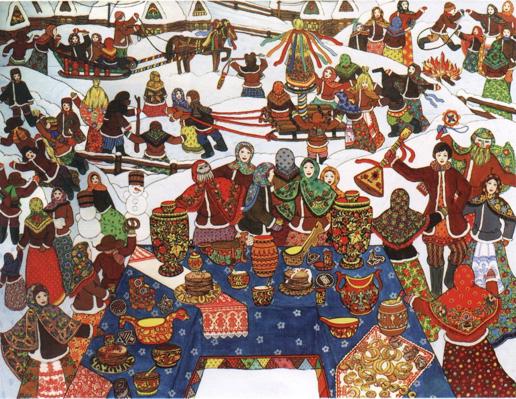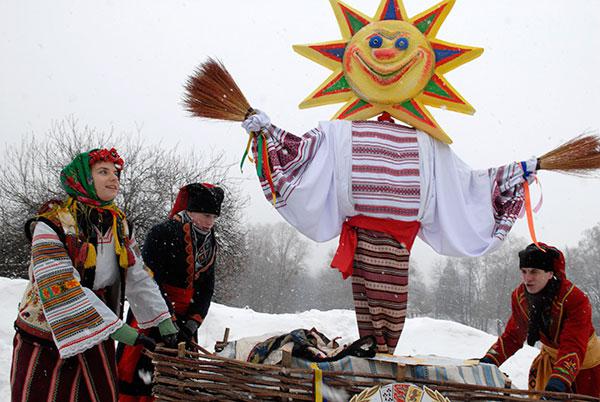Shrovetide is one of the few national holidays with a history of many thousands of years, which is still celebrated by Russians today. True, of the dozens of rituals invented for seeing off winter on the eve of Lent, our contemporaries know from the strength of 5-6. Moreover, many do not know why and when Maslenitsa appeared in Russia. The history of the holiday is interesting for children, who are especially attracted by fun games and entertainments, as well as delicious traditional treats. For example, it is difficult to find a child who does not like pancakes and pancakes!
Pagan holidays
Rites of the meeting of spring and the farewell of winter existed among many sedentary peoples in the days of paganism. In particular, the Slavs from time immemorial celebrated the day of the spring solstice. There is also an alternative opinion that the history of Shrovetide dates back to the time when the cult of the god Veles, who was the patron of cattle breeding and agriculture, existed. His feast was held on February 24th in a new style and preceded the meeting of the new year, which until March 1492 began.
Carnival
Many researchers believe that the history of the Shrovetide originates from the era of antiquity. And indeed, a holiday similar to the Slavic farewells of winter existed even in Ancient Rome. After the adoption of Christianity by Emperor Constantine and in the next 1-2 centuries, the church sharply faced the question of the eradication of paganism. To this end, many holidays of the new religion were postponed to dates corresponding to the days when it was customary to glorify the ancient Roman gods. In particular, the borders of Great Lent were somewhat shifted, and instead of bacchanalia and saturnalia religious processions began to be held. By the way, not many people know that the French word “carnival” is translated as “goodbye meat” and is consonant with the second ancient name of the Russian Pancake Week - Meat and Paste. For the first time, carnivals in the modern sense in most European cities began to take place in the 9th century. By this time, the church had already strengthened its positions, and the clergy were less zealous in fighting the remnants of the pagan past, especially since the first half of the festive week was accompanied by numerous religious ceremonies.

The history of the celebration of Maslenitsa in Russia: the origins
As you know, Christianity came to us from the Byzantine Empire, which is the heiress of the culture of Ancient Greece. That is why the history of Maslenitsa in Russia is a mixture of Slavic rites with the Orthodox traditions of festivities on the eve of Great Lent. The latter, in turn, arose as a continuation of the processions in honor of the god Dionysius.
Shrovetide and Lent
Sometimes people tend to idealize the past and forget that Russia until the 18th century was an agrarian country, where the majority of the population were peasants. Their wealth directly depended on weather conditions, so in lean years many had to deal with such a thing as hunger. Thus, satisfying to eat for many was one of the few pleasures available, so any holiday turned into a feast. The foregoing is especially obvious when considering the history of the origin of Shrovetide. In particular, many researchers believe that Great Lent, in addition to religious subtext, also had a completely utilitarian meaning. Indeed, at the end of winter and the beginning of spring, peasants ran out of food supplies, and strict abstinence allowed them to “hold out” until spring, when mushrooms and greens appeared. At the same time, calving began in early February, so there was a lot of milk from which butter and cheese were made. During the post they managed to harvest them for the future, so after Easter the peasants were provided with high-calorie foods, which was very useful during the sowing days. Before giving up hearty meals for a long time, peasants and representatives of other classes had fun and indulged in gluttony. And how the history of the emergence of Maslenitsa evolved depended on the tastes and preferences of the princes and kings.

Celebration under Peter the Great
In the first half of the 18th century, some European traditions penetrated into Russia. In particular, in 1722, at the end of a protracted war with Sweden, Emperor Peter the First invited foreign ambassadors to take part in the oil festivities. In order to surprise Europe, an unprecedented spectacle was arranged: the tsar rode through the snow on a ship harnessed by sixteen horses, and after it the gondola with Tsarina Catherine in the costume of a simple peasant “sailed”. And that's not all! Other ships, harnessed by various beasts that drove the courtiers, moved behind the royal persons. All this was accompanied by loud music and illumination and made a lasting impression on the audience.
Shrovetide celebration under Catherine II
The history of Shrovetide also contains several interesting pages related to the name of Catherine the Second. In particular, she introduced the custom of organizing masquerade processions in Moscow, where she moved with the whole yard at the end of winter. For the first time, such a spectacle residents of the city and foreign guests were able to admire on the day of the coronation of the empress. A total of 4,000 people and 200 chariots took part in the march.
There is also such a story of the celebration of Maslenitsa, relating to the era of the reign of Catherine the Second: on the occasion of the birth of the grandson of Alexander, the Empress arranged festivities of unprecedented scope. In particular, it is known that the courtiers, who became winners in the games started after dinner, were given precious gifts. In just one evening, the Empress gave away 150 jewelry, for which the Pancake Week of 1777 was nicknamed Diamond.
Traditions
The history of Maslenitsa has preserved to us a description of special rites. At the same time, our ancestors had a Pancake week by the day, and each had a special name:
“Meeting” - Monday;
“Flirting” is a Tuesday;
“Gourmet” - medium;
“Wide walk-four” - Thursday;
“Mother-in-law's supper” - Friday;
“Zolovkin gatherings” - Saturday;
“Forgiven day” is Sunday.
Activities such as ice skating and sleigh rides, ceremonies associated with the newlyweds, processions of the mummers, fist fights and group competitions were popular. For example, the participants of the games were divided into two groups and fought or staged a capture of a snowy town. And, of course, Shrovetide was inconceivable without burning a scarecrow, which looked different in different regions.
Treat
As already mentioned, Maslenitsa was the last opportunity to eat plenty before a long Lent. The traditional treat consisted of dairy products (sour cream, cottage cheese, cheese) and eggs, as well as all kinds of flour products, such as cheesecakes, pancakes, bacon, tortillas and brushwood. As for drinks, beer was preferred.
Maslenitsa holiday: a story for children
To preserve the traditions of the Russian people, it is extremely important to familiarize children with their culture from an early age. This also applies to Shrovetide. After all, this holiday is one of the few that have come down to us almost unchanged. Teachers advise to start acquaintance of kids with Shrovetide with the story that once upon a time our ancestors, tired of the long winter, decided to arrange her funny farewells. And what fun without children's games and fun ?! Therefore, comic contests were invented, the participants of which could find out which of them was the most daring and dexterous fellow.
In addition, if you want to arrange a holiday "Maslenitsa: a story for children" in kindergarten, you should learn various jokes and jokes with the kids. Despite the fact that they were invented several centuries ago, today they are a good tool for introducing kids to their national culture.
Now you know how Maslenitsa was celebrated in Russia. The history of the holiday is full of interesting facts that are likely to be interesting to both adults and children.